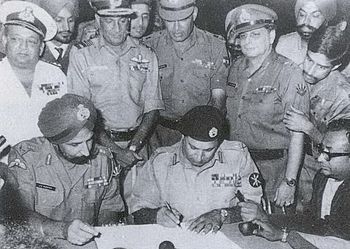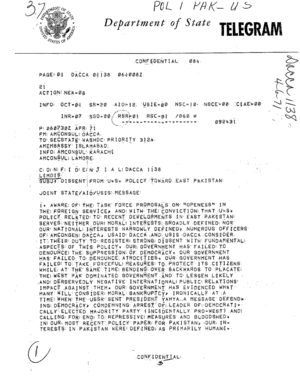Indo-Pakistani War of 1971 facts for kids
Quick facts for kids Indo-Pakistani War of 1971 |
|||||||||
|---|---|---|---|---|---|---|---|---|---|
| Part of the Indo-Pakistani wars and conflicts and Bangladesh Liberation War | |||||||||
 First Row: Lt-Gen. A.A.K. Niazi, the Cdr. of Pakistani Eastern Comnd., signing the documented instrument in Dacca in the presence of Lt. Gen. Jagjit Singh Aurora (GOC-in-C of Indian Eastern Comnd.). Surojit Sen of All India Radio is seen holding a microphone on the right. Second Row (left to right): Vice Adm. N. Krishnan (FOC-in-C Eastern Naval Comnd.), Air Mshl. H.C. Dewan, (AOC-in-C Eastern Air Comnd., Lt Gen. Sagat Singh (Cdr. IV Corps), Maj Gen. JFR Jacob (COS Eastern Comnd.) and Flt Lt Krishnamurthy (peering over Jacob‘s shoulder). |
|||||||||
|
|||||||||
| Belligerents | |||||||||
|
|
East Pakistan |
||||||||
| Commanders and leaders | |||||||||
(Prime Minister of India) (President of India) (External Minister of India) (Defence Minister of India) (Chief of Army Staff) (GOC-in-C, Eastern Command) (GOC-in-C, Southern Command) (GOC-in-C, Western Command) (GOC-in-C, Central Command) (GOC-in-C, IV Corps) (GOC-in-C, II Corps) (GOC-in-C, XV Corps) (GOC-in-C, I Corps) (COS, Eastern Command) (COS, IV Corps) (Dir, Military Operations) (Chief of Naval Staff) (Cdr. Western Naval Command) (Cdr. Eastern Naval Command) (Cdr. Eastern Fleet) (Chief of Air Staff) (Director of RAW) (PM Provisional Government) (Commander, Mukti Bahini) |
(President of Pakistan) (Prime Minister of Pakistan) (Chief of Staff, Army GHQ) (Commander, Eastern Command) (Chief of General Staff) (Commander, I Corps) (Commander, II Corps) (Commander, IV Corps) (GOC, 23rd Infantry Division) (GOC, 14th Infantry Division) (Cdr-in-Chief, Navy) (COS, Navy NHQ) (Cdr, Eastern Naval Command) (Cdr, Western Naval Command) (Commander, Pakistan Marines) (Cdr-in-Chief, Air Force) (Chief Ins, Pakistan Air Force) (Cdr Eastern Air Command) (COS, Air AHQ Dhaka) Abdul Motaleb Malik (Governor of East Pakistan) |
||||||||
| Strength | |||||||||
| Indian Armed Forces: 1,000,000 Mukti Bahini: 180,000 Total: 1,180,000 |
Pakistan Armed Forces: 350,000 | ||||||||
| Casualties and losses | |||||||||
|
Pakistani claims
Indian claims
Neutral claims
|
Pakistani claims
Indian claims
Neutral claims
|
||||||||
The Indo-Pakistani War of 1971 was a military conflict between India and Pakistan. Lasting just 13 days, it is considered one of the shortest wars in history.
During the war, Indian and Pakistani forces fought on the eastern and western fronts. The war effectively came to an end after the Eastern Command of the Pakistani Armed Forces signed the Instrument of Surrender (1971) on December 16, 1971. After the surrender, East Pakistan seceded as the independent state of Bangladesh. Around 97,368 West Pakistanis who were in East Pakistan at the time of its independence, including some 79,700 Pakistan Army soldiers and paramilitary personnel and 12,500 civilians, were taken as prisoners of war by India.
Western and Soviet involvement
The Soviet Union sided with the Bangladeshis, and supported the Indian Army and Mukti Bahini during the war. The Soviets thought that the independence of Bangladesh would weaken the position of its rivals—the United States and China. The USSR gave assurances to India that if a confrontation with the United States or China developed, it would take counter-measures. This assurance was enshrined in the Indo-Soviet friendship treaty signed in August 1971.
The United States supported Pakistan politically and with supplies. President Richard Nixon and his Secretary of State Henry Kissinger feared Soviet expansion into South and Southeast Asia. Pakistan was a close ally of the People's Republic of China, with whom Nixon had been negotiating a rapprochement. Nixon was planning to visit China in February 1972. Nixon feared that an Indian invasion of West Pakistan would give the Soviets control over the region. It would seriously undermine the global position of the United States and the regional position of America's new tacit ally, China. In order to demonstrate to China the bona fides of the United States as an ally, Nixon sent military supplies to Pakistan, routing them through Jordan and Iran, while also encouraging China to increase its arms supplies to Pakistan. The Nixon administration also ignored reports it received of the "genocidal" activities of the Pakistani Army in East Pakistan, most notably the Blood telegram. This prompted widespread criticism and condemnation both by Congress and in the international press. The United States introduced a resolution in the UN Security Council calling for a cease-fire and the withdrawal of armed forces by India and Pakistan. It was vetoed by the Soviet Union. In the following days Nixon and Kissinger tried to get India to withdraw, but they did not succeed.
President Nixon requested Iran and Jordan to send their F-86, F-104 and F-5 fighter jets in aid of Pakistan.
When Pakistan's defeat in the eastern sector seemed certain, Nixon deployed a carrier battle group led by the aircraft carrier USS Enterprise into the Bay of Bengal. The Enterprise and its escort ships arrived on station on 11 December 1971. According to a Russian documentary, the United Kingdom deployed a carrier battle group led by the aircraft carrier HMS Eagle to the Bay.
On 6 December and 13 December, the Soviet Navy dispatched two groups of cruisers and destroyers and a submarine armed with nuclear missiles from Vladivostok; they trailed U.S. Task Force 74 into the Indian Ocean from 18 December 1971 until 7 January 1972. The Soviets also had a nuclear submarine to help ward off the threat posed by USS Enterprise task force in the Indian Ocean.
Images for kids
-
Pakistan's PNS Ghazi sank off the fairway buoy of Visakhapatnam near the eastern coast of India, making it the first submarine casualty in the waters around the Indian subcontinent.
-
Indian Air Force MiG-21s during the war.
-
The Indian T-55 tanks penetrating the Indo-East Pakistan border towards Dacca.
See also
 In Spanish: Guerra indo-pakistaní de 1971 para niños
In Spanish: Guerra indo-pakistaní de 1971 para niños










